 Research Article
Research Article
Mobile Modular Systems of Water Treatment and Storage in Crises – Solutions used Depending on the Type of Threats
Paweł Wolny1*, Norbert Tuśnio2 and Wojciech Wróblewski3
1Faculty of Process and Environmental Engineering, Lodz University of Technology, Poland
2The Main School of Fire Service, Faculty of Safety Engineering and Civil Protection, Poland
3The Main School of Fire Service, Internal Security Institute; Poland
Paweł Wolny, Faculty of Process and Environmental Engineering, Lodz University of Technology, Poland
Received Date: September 22, 2021; Published Date: October 04, 2021
Abstract
Various methods of water purification aim to obtain such a purity class that makes it suitable for consumption are presented in the article. It is a review of solutions, ranging from methods known and used for over 100 years, through research and experiments underway, to only a concept. Some of the solutions are so effective that they should also be combined with safe storage of purified water. Flexible tanks are used for this, which significantly improve logistics and provide a supply of water in all places where it is needed. Depending on whether the lack of drinking water results from a sudden change in the situation resulting from a natural or technical disaster, or whether it is a continuous state, e.g., from prolonged drought, a drastic reduction in water quality or its lack due to permanently damaged or non-existent water supply infrastructure, each of the described cases requires the use of different solutions, which will be described in the article based on solutions applied or developed for very specific existing situations. Each of the applied solutions has its advantages and disadvantages, and the aim of this analysis is to present a concept based on existing solutions but eliminating some of their disadvantages with the maximum use of advantages.
Keywords: Water supply, Crisis situation, Safety of water supply, Flood, Water decontamination, Water filtration, Flexible tanks
Introduction
The review aims to draw attention to the problems of drinking water supply during technological and natural disasters or other reasons for its shortage and demonstrate the advantage of solutions based on the treatment of on-site water over its supply from areas not affected by the incident. Another aspect of the analysis is the assessment of the eco-nomic elements of individual solutions. The ongoing climate changes have a significant impact on both surface and groundwater resources and human activities, such as industrialization [1].
The provision of potable water is a crucial goal in emergency situations and areas where there is simply no water with the correct parameters. Contrary to the popular opin-ion resulting from a particular mental shortcut, the problem is not the lack of water in the world because 71% of the surface of our globe is made of water. On the other hand, the real challenge for humanity is access to drinking water. Freshwater accounts for only 2.5% of global water resources, and only 1% of this part (77% glaciers and 22% groundwater) is available for consumption. However, it also requires additional treatment in many cases. In the European Union, the Water Framework Directive (WFD) is in force, which requires the member states to develop water quality improvement programs. In the case of water of the highest ecological purity class, not to deteriorate its parameters. The availability of water resources and the ability to renew them in the EU countries is highly uneven. Table 1 shows the 5 countries with the highest renewable water resources per capita and the 5 countries with the lowest resources in Europe and Table 2 in the world.
Table 1: Total internal renewable water resources per capita in 2017 (Europe).

1FAO 2021. AQUASTAT Database. AQUASTAT Website accessed on 20/02/2021 [2].
Table 2: Total internal renewable water resources per capita in 2017 (World).

*in Kuwait the total renewable water resources (TRWR) is 10 m3/inhabitant 1FAO 2021. AQUASTAT Database. AQUASTAT Website accessed on 20/02/2021 [2].
As shown in the tables, only a few countries have a sufficient amount of readily available and renewable sources of clean water. These resources are not forever given – it is influenced by climate change and industrial development, or the increasing population. Therefore, even in such places, care should be taken to create systems for the purification and recovery of drinking water.
Water Purification and Treatment Technologies
Contrary to what it may seem, the problem with drinking water quality was recognized as early as the beginning of the 19th century. However, archaeological findings indicate activities to improve drinking water quality in ancient Greece. This subsection presents the various water treatment and purification methods most commonly found in the literature, from the oldest and least efficient to the most technologically advanced and capable of providing high water quality in industrial quantities. In the article, it will be cited various methods or tools for water filtration like:
Ceramic filters
Ceramic filters are used in poorly urbanized and lowindustrialized countries with-out access to the most modern solutions, such as Guatemala, Cambodia, Nepal, or Nica-ragua [3- 5]. They are one of the oldest water filtration methods known to mankind. In Victorian England (1827), Henry Doulton (potter and inventor), commissioned by the ruler, constructed an effective gravitational filter. It was possible to remove from drinking water, among others, comma cholera. Ceramic filters are still used today. Research conducted in Guatemala combined the classic technology of clay and sawdust filters with modern solutions, such as adding silver nanoparticles. In the conducted field tests, the number of E. coli bacteria removed was approximately 90% [4].
The advantage of ceramic filters is their widespread availability due to technology that has been known for centuries and for their production, whereby all you need is clay, sawdust or rice husks. If carefully made, it can remove up to 99% of pathogenic bacteria, as well as water clouding. However, their effectiveness in relation to the needs is negligible (you can get from 0.5 to 4 liters of filtered water daily). They are easily damaged, require regular cleaning, and it is practically impossible to maintain a uniform quality standard in this type of production [5].
Prefiltering
Prefiltering is a process for retaining solid particles larger than 100 μm (e.g. sand, fine stones) and is commonly used as a pretreatment method before membrane filtration. Pre-filtration can be applied to the membrane filtration system as a whole and each mem-brane unit separately. The specific size of the filter holes is related to the pre-filtration process. It differs depending on the choice of membrane filters and the primary quality of the water subjected to the treatment process [6].
SODIS
In extreme situations, where it is impossible to supply or activate filter systems, the simplest method of removing pathogenic bacteria is SODIS, i.e. the solar water disinfection technique using a PET bottle. The technique consists of long-term exposure of water placed in a transparent plastic bottle to the influence of UV-A solar radiation. Research on the effectiveness of this method and other solutions based on UV radiation, where the main criterion was the price, was conducted in African countries [7, 8]. Field tests of the low-pressure ultrafiltration method for removing solid and colloidal particles and partial disinfection of water were also carried out [9].
Reverse osmosis
It is process based on forced diffusion of a solvent through a semipermeable membrane separating two solutions of different concentration; takes the direction from a solution with a higher concentration of a solute to a solution with a lower concentration (it leads to an increase in the concentration difference of both solutions) and is caused by ap-plying a higher pressure to the membrane and directed against the osmotic pressure naturally present in the system.
Active carbon filters
Based on information from [10], the first known activated carbon filtration devices come from ancient Crete, where, during archaeological research in an aqueduct, conical terracotta filters containing charcoal were discovered. Activated carbon filtration is one of the many processes commonly used in water treatment to remove contaminants such as organic materials. Because it can also remove odor-causing pollutants, it is often used to improve the taste of water.
Activated Filter Media
AFM® – patented filter technology replacing sand filters with specially processed glass significantly reduces the entry of parasites and bacteria, easy to decontaminate, un-like sand filters, it is enough to rinse it with a water return stream.
Ultrafiltration
Process-based on low-pressure membrane systems used to eliminate emulsions such as oils, compounds of oxidized metals, solid particles as well as viruses and bacteria with a diameter of up to 0.01 μm. It does not remove radioactive isotopes, viruses, salt, and sugars and is usually combined with a UV filter.
Nanotechnology
Water purification and treatment, e.g. for obtaining fresh water from seawater, pre-venting environmental pollution, and creating methods for removing pollutants from water and soil, can be done using nanotechnology [11]. According to some scientists, the potential of nanomaterials is so great that it will be possible to develop large-scale water and environmental purification technology in the near future.
UV-C sterilization
It’s a type of photochemical disinfection of water, aimed at damaging the DNA of pathogens.
However, the process of water sterilization using UV radiation to destroy microbes in drinking water is not as effective as chlorination, and often e-coli bacteria and other bacteria remain in the drinking water, although studies conducted in Ogbomoso (Nigeria) do not confirm this thesis [12].
In the case of water shortage during natural disasters such as drought or flooding or man-made disasters, where there is chemical or biological contamination of water re-sources, ensuring sufficient water for social and living purposes is one of the key tasks of emergency services. Currently, the most popular in the world are two forms of drinking water supply in emergency or crisis situations:
I. bottled water that can be delivered even from long distances,
II. drinking water supplied by water tankers from shorter distances, which requires the recipient to provide containers for its withdrawal [13].
This poses a tremendous logistical challenge for emergency services due to the need to commit significant forces and resources to ensure sufficient water supply to all those in need. It requires the collection of a large number of vehicles adapted to the transport of water without unit packages or a bottled water distribution center in the affected areas because it is often impossible for truck tractors with trailers to reach customers directly (due to the damaged road infrastructure or the lack of roads with the required load capacity).
This also increases traffic in these areas, which in the event of high dynamics of events may have an adverse effect on the capacity of roads for intervention units (along with the materials and equipment necessary for these activities) to combat the effects of a disaster prevent its extension.
Another aspect is the efficiency of the transport system depending on the distance to drinking water intakes or logistic centers with water portioned in individual containers. In the case of low efficiency of drinking water intakes, it may be necessary to ration it or create a situation of its temporary shortage for purposes other than human consumption. The solution to eliminating these disadvantages and limitations is filtration devices with high efficiency and flexible tanks that require much less cargo space during transport than in the case of rigid tanks. The use of a two-phase filtration system significantly speeds up the process of obtaining water for domestic purposes, i.e., activities that do not require drink-ing water, such as washing or hygiene [14].
An exact determination of the minimum amount of drinking water needed in a given area is practically impossible because the individual characteristics of an individual are of crucial importance to its demand. The selected parameters that should be taken into account when determining individual needs include: gender, age, type of diet, load resulting from physical activity, and they will depend on the ambient temperature and air humidity. The higher temperature and the lower the air humidity (water loss due to sweating) and the increase in altitude (increased water loss in the exhaled air), the greater the water demand. Interestingly, the water balance is also influenced by low temperature due to the increased energy expenditure. The need to use a high-calorie diet increases the need for water necessary to metabolism more nutrients. A diet high in fiber and sodium also contributes to increased liquid requirements [15].
Polish legal regulations define the minimum demand for drinking water depending on how the water will be rationed. In the case of a short-term water shortage, the amount is 2.5 dm3/ person per day, but if this time is extended, the minimums increase according-ly:
I. for several days – 7.5 dm3/person per day,
II. for several weeks – 15 dm3/person per day,
A sufficient amount of water for vital purposes is considered as 30 dm3/person per day [16,17].
Water consumption related to the provision of personal hygiene, i.e. washing, show-ering in field conditions, washing, etc., consumes several dozen liters per person per day. However, these activities do not require the use of water of the highest purity.
As recommended by the World Health Organization, two liters is the minimum re-quired to maintain fluid balance. On the other hand, the report of the Institute of Medicine of the National Academies states that the average demand for women is about 2.7 liters each day and that of men, on average, about 3.7 liters a day (taking into account the fluids contained in drinks and food) [18].
Providing sufficient water to meet the basic needs of people and animals in areas affected by natural or technical disasters is a huge challenge for logistics and quartermaster services. The criteria that should be followed by persons making decisions regarding selecting the most optimal technology for emergency water supply in a given specific situation are summarized in [19]. The preliminary assessment must consider meteorological conditions, road availability and capacity, water quality, and demand. After this preselection, the following components of the right choice are: costs, ease of deployment and use, environmental impact, maintenance, performance, potential acceptance, energy requirement, supply chain requirement, water filtration efficiency. For the needs of large countries such as China, due to rapid industrialization, major accidents led to contamination of water bodies [20] and in the USA, wherein 2007-2008 there were 36 outbreaks of infectious diseases in drinking water [21].
The study aims to collect arguments indicating the legitimacy of implementing the proposed solution based on the currently existing stationary technology designed by Romanian start-up KHAR. The critical parameters for creating a modular mobile water purification system will be the response time to a crisis and the delivery of the necessary amounts of water to the areas affected by the disaster, the amount of water that can be delivered depending on the adopted solution, and the costs reflected in the price of a liter of water.
Materials and Methods
A retrospective analysis was carried out including a media and literature review. This retrospective analysis was carried out using databases of scientific articles, including governmental documents, developed, and partially implemented projects description for solving existing problems with portable water in Africa (Uganda, South Africa), using the following phrases and keywords: water supply, crisis situation, the safety of water supply, flood, water decontamination, water filtration, flexible tanks. As part of the analysis of solutions to provide water in crisis situations, various ways of supplying drinking water were identified, e.g. during a flood, earthquake, etc. The minimum required amount of water necessary for people for social and living purposes was also established. Several concepts of mobile filtering installations, including those transported in containers, have been described. Particular attention was paid to the system developed in Romania, which can be successfully used to ensure continuity of water supply in small groups of people. The authors’ proposals are: installation of many filter sets on the chassis of a heavy off-road vehicle, which will be used to drive anywhere in the disaster, and a method of storing water in flexible reservoirs. The effectiveness of three water supply solutions related to moving people or staying in their place of residence was assessed. The economic aspect was emphasized by comparing the costs of transport and the time of obtaining drinking water using typical logistic methods (by trucks) and using the authors’ proposals.
Mobile Filtering Systems
There are mobile systems on the market with a multi-stage filtration process that re-move solid particles, bacteria, and viruses, making the water drinkable. The end user receives water that is clean and free from biological contamination. Portable reverse osmosis systems (Figures 1 & 2) are capable of removing hazardous substances and salts from seawater as well as from chemically polluted water.

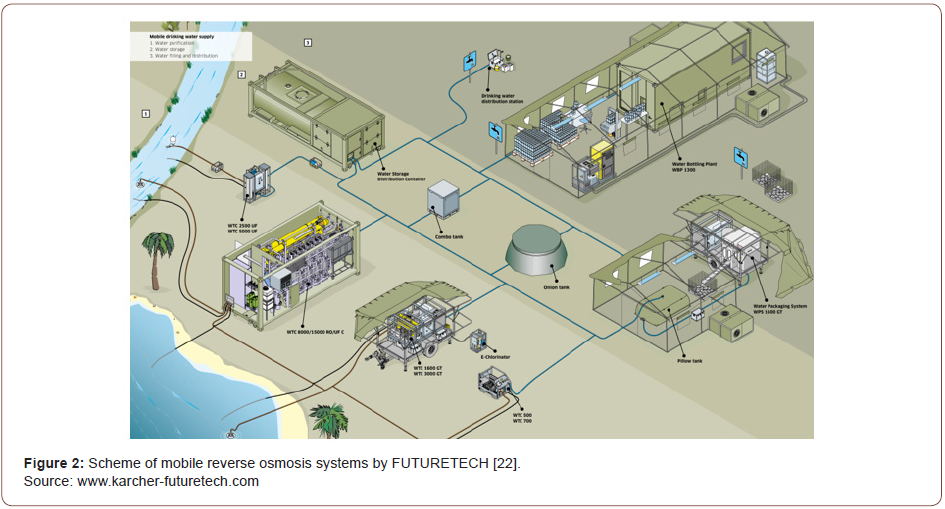
According to the manufacturer’s declaration, systems operating based on reverse osmosis (forced diffusion of the solvent through a semipermeable membrane separating two solutions of different concentrations) provide the highest level of purity of the filtered water. The reverse osmosis membrane uses all the ultra-filtration capabilities of freshwater and can remove chemicals and salt from brackish and saltwater and chemically contaminated water. Thus, substances that are retained by the reverse osmosis membrane include small and large solid impurities, viruses, microorganisms, and various chemical compounds, including salts.
In the United States, water purification systems are shipped in 20’ or 40’ containers on a plug & play basis, ready to go immediately after connecting the power supply. These kits are designed for rapid response in emergencies as supplementary or temporary drinking water sources (Figure 3).
The use of high efficiency water filtering systems should be an element of an internal crisis management plan, especially for large enterprises, where large amounts of good-quality water are used in the technological process [23,24].
A solution based on a water purification mechanism other than reverse osmosis is the SOWAT filtration system (System of Open Water Advanced Technology) developed by the Romanian company KHAR. It consists of mechanical filters and works without the need for chemicals or UV-C sterilization, providing drinking water without eliminating the minerals contained in it so that the filtered water does not require additional mineralization.
Thanks to the involvement of experts from various industries in the project, it was possible to develop an effective system which, although it was a start-up and was to serve mainly research and development purposes, has become a fully-fledged solution used practically both in Romania and after the flood caused by heavy rains in Madagascar in the Atsinanana region. The efficiency of a single module was estimated at min. 4,800 dm3/h, which in the producer’s opinion will ensure the demand for water for 5,000 people a day. The great advantage is the ability to bring the water of any quality (including highly contaminated) to the drinking water class. The filter system removes contaminants up to a diameter of 10 nanometers, which allows the almost complete removal of not only solid particles but also bacteria and viruses. With such efficiency, the system can be an exciting solution in crisis situations and places with significant shortages of the highest quality water. The part of the water filtration system is shown in Figure 4.
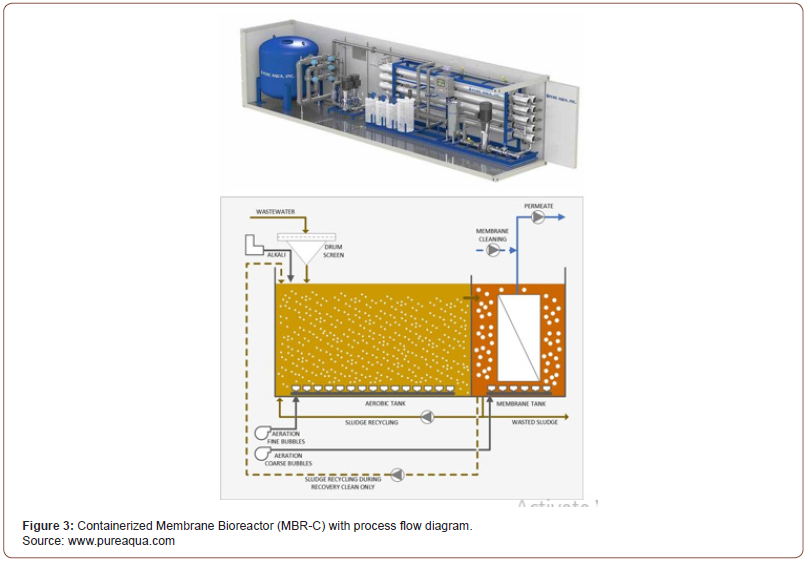
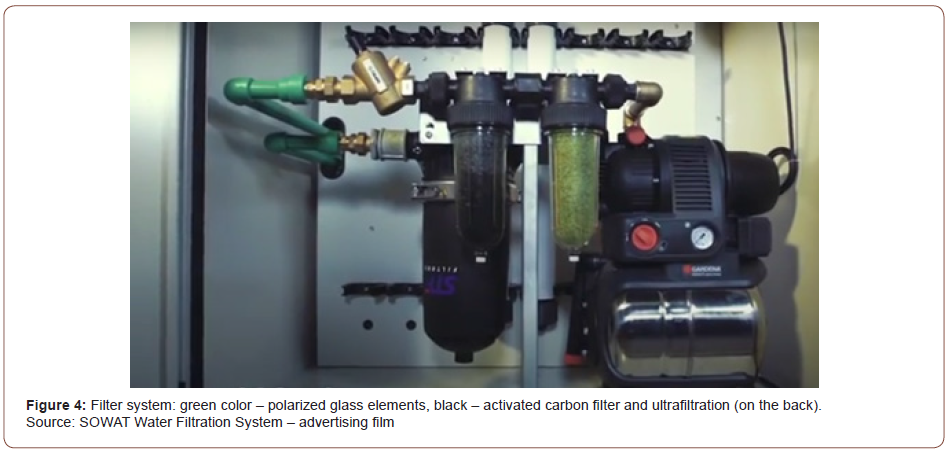
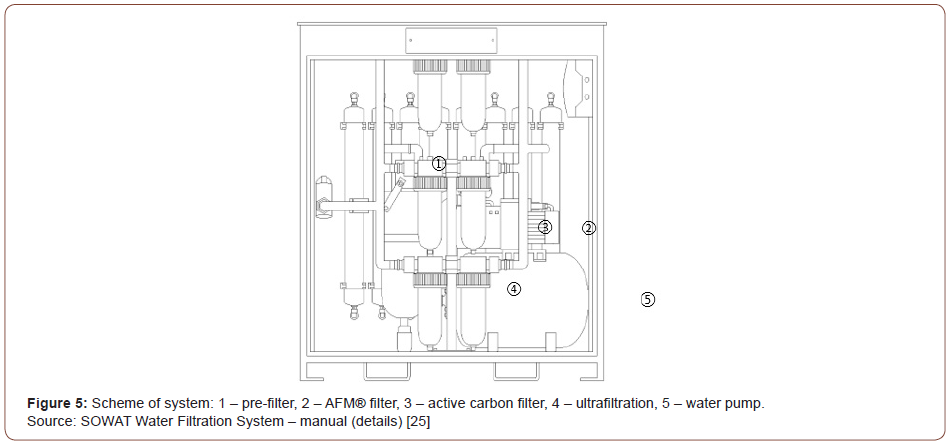

Scheme of system is shown in Fig. 5 and a prototype installation made in Cornățel (Romania) is shown in Figure 6 (Figure 5 & 6).
At this stage of the project’s advancement, the requirements for the installation of filter modules have emerged, the fulfillment of which is necessary for their proper operation. First of all, they should be protected against flooding, placed on a stable surface in a vertical orientation. They also require thermal protection, as they can function in a reasonably limited temperature range (5-35 °C).
For the automatic cleaning of membrane filters of collected contaminants (to maintain the highest water quality and efficiency), the installation requires a connection to a waste container. After this operation, the water used for servicing is not potable [25].
Flexible Drinking Water Tanks
As already mentioned, rigid water tanks are a tremendous logistical problem, and they can be easily replaced with an alternative solution, which is another type made of flexible synthetic materials. They can be transported in the form of relatively small packages. An example of such a system of tanks, used in Poland by the military for both fuel and water storage, are the products of the American company MPC Containment Systems LTD [26].
The tanks are equipped with filling hoses and mechanical valves with quick-connect Camlock couplings that also allow their ventilation. The use of rounded sides of the tank increases its resistance to damage during filling, thanks to a more even hydrostatic pressure distribution. This also translates into the elimination of leaks and extension of its service life.
It is a solution used in many armies of the world, and its resistance to climatic conditions enables them to be used in combat conditions in both temperate and hot climates.
The Americans are not the only suppliers of such solutions, and the armed forces are their only recipients. Many manufacturers offer a wide range of systems for temporary storage and delivery of fuel (or water) – these are European and Asian companies. This solution is used not only for military purposes but also for humanitarian and commercial purposes. The modular structure of such systems enables the creation of fuel or drinking water bases ranging from a single tank to the logistics base of large strategic operations, tailored to individual needs. There is a wide variety of tank sizes, e.g. MPC offers capacities: 11, 25, 38, 76, 190 and 795 m3. An example of a flexible tank with a capacity of 190 m3 is shown in the photo (Figure 7).

Their transport weight is respectively: 311, 398, 414, 429, 512 and 845 kg. Folded tanks are transported in reusable wooden crates with all necessary equipment. The disas-sembly and assembly of all the elements of the tanks must be done by hand (Figure 8).

Water supply systems in crisis situations
The use of mobile water treatment solutions occurs not only in sudden events such as all kinds of disasters but also when the shortage of potable water is a long-term process. An example of such a situation is the consequences of hostilities. As a result of the Second Gulf War, much of the critical infrastructure in Iraq, including the water supply, was destroyed. However, their reconstruction was a long-term process that required finding alternative solutions implemented quickly. A solution developed by Applied Membranes, Inc. was used to accomplish this task.
To cover the necessary minimum demand for clean water, 400 mobile units with 7-stage filtration, with a volumetric flow rate of up to 5 m3/h each, were prepared. In order to become independent from external sources of electricity, power was supplied from photovoltaic cells placed on trailers (Figure 9). Thanks to this solution, they can be used in areas without electricity. The main threat to the population was water contamination with cholera commas. Therefore, one of the stages of water filtration and disinfection is the removal of all kinds of bacteria using ultraviolet radiation, the effectiveness of which in these modules has been confirmed by independent certified laboratories (Figure 9).

In disaster-stricken areas or continuously deprived of drinking water, there is also the problem of supplying the filter modules with electricity. In the case of small, self-sufficient filtering systems, they are powered by solar panels and battery systems that collect energy when the sun is less active or not active at night. Such a solution is presented in the form of a diagram in Figure 10.

Systems for filtering and storing drinking water and delivering it to areas affected by various natural disasters have already been used many times, e.g. after earthquakes, floods, and other natural disasters. After the 2015 Nepal earthquake, Kärcher Futuretech GmbH’s systems were widely used during a humanitarian operation. Two WTC 5000 UF water treatment plants operated in Kathmandu, treating 10,000 liters of water per hour for consumption, which allowed 30,000 people to have constant access to drinking water. The water was distributed directly on-site or delivered using tanks on trucks. The described installation is shown in Figure 11.
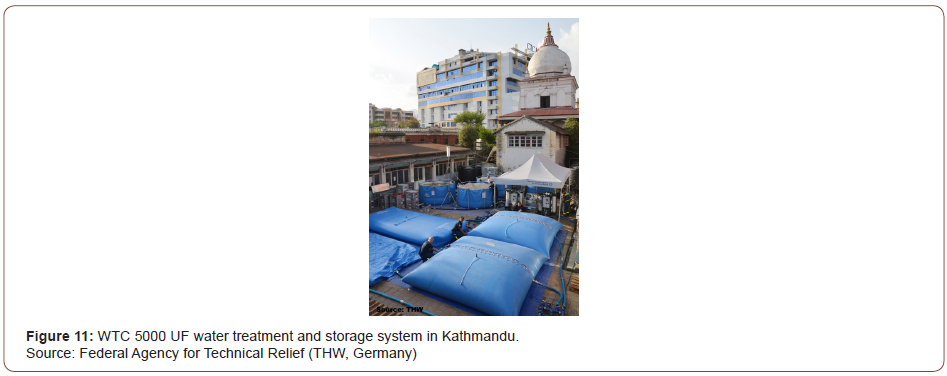
Solution proposed by the authors
According to the authors, the currently presented solutions for mobile water treatment plants can be improved to some extent. The weak points of the solution using car trailers are: maximum permissible speeds with a trailer and maneuvering in rugged terrain. In the case of a container solution, a truck with a semitrailer is necessary, the mobility of which in wetlands or sandy areas is very limited [27-29].
Additionally, the mobility of the existing system is understood as transporting the system to designated places of assisting the injured, but its frequent relocation is not expected. The authors propose that a truly mobile unit be used to provide drinking water in many locations affected by natural or technical disasters. As presented in the introduction, the key parameters are the time of supplying drinking water to people in need, the efficiency of the system or system solution, as well as the cost of obtaining a portion of water (20 l is the minimum amount in the climatic conditions of the African continent). The analysis used: business projects aimed at providing cheap drinking water in Africa (Uganda, South Africa), simulations of necessary activities to ensure water supply for sheep breeding in Australia, report of the Polish Supreme Audit Office on the supply of drinking water to the population in large cities in the event of dis-asters, a US Government Agenda study that assessed the suitability and effectiveness of ceramic filters made by local communities. The result of these considerations are conclusions about the strengths and weaknesses of individual solutions. The basic assessed parameters are the efficiency of water supply systems and the cost of obtaining or delivering the necessary portion of water. The results of our analyzes are presented in Table 3.
Table 3: Comparing the different solutions of water supply: water delivery (bottles, cisterns), filtering for the needs of individual farms, high efficiency filtering (mobile systems).
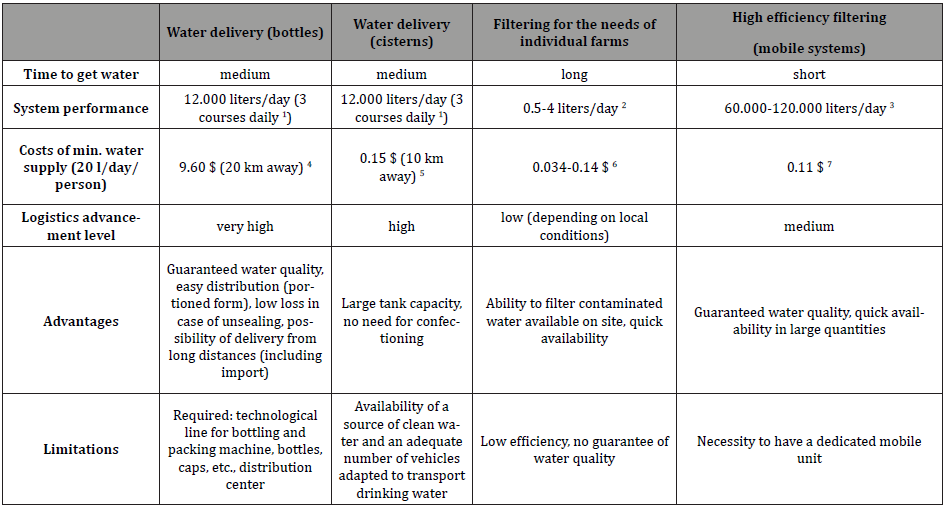
1Supreme Audit Office (2017) Ensuring the safety of water supply in large urban agglomerations in the event of crisis situations. Report, Katowice,
Poland [28].
2Dies, R (2003) Development of a Ceramic Water Filter for Nepal. Master of Engineering Thesis, The Massachusetts Institute of Technology, Cambridge,
USA [5].
3Fraunhofer IST (2019) SafeWaterAfrica Deliverable Report D6.4 Business Models. Braunschweig, Germany [29]
4Cost of 20 l bottle of water is 9.55 $, light truck (capacity 4 t, mileage 10.0 km/l), fuel cost 1.082 $/l
5COERCO (2020) Costs of carting water you may not know about (and what to do). Simulation with cistern capacity 4 t, Dalwallinu, Australia [30].
6Centers for Disease Control and Prevention, Ceramic Filtration. Washington, D.C., USA, 2012 [31].
7Bazira H. et. al., (2020) Promoting Cashless “Pay-n-Go” Miners Water Project in Uganda. Business plan, Water Governance Institute, Kampala,
Uganda [32]
The proposed solution is to install 4 or 6 sets of filters on the chassis of a heavy off-road vehicle (proposal – Figure 12). This proposal solves problems related to stabilization and the required working conditions (for example, the SOWAT system should be placed vertically, on hard ground, protected against flooding, used in the temperature range from 5 to 35 °C). Flexible reservoirs of various capacities can be used to provide water supply even for small groups of people in the affected areas. Their transport can be provided by a vehicle with a tarpaulin and HDS system (Figure 13).
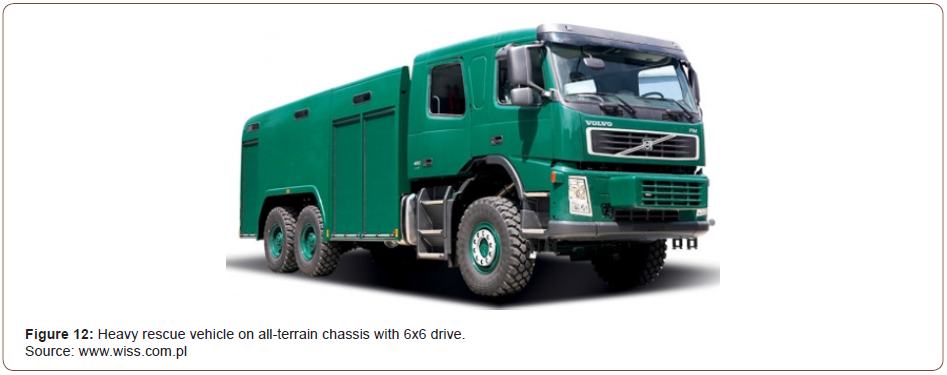

The third element of a mobile drinking water supply set can be a laboratory where the water quality will be confirmed. To ensure maximum efficiency of the proposed solution, the third vehicle should be equipped (in addition to the laboratory) with additional filters and spare parts, an emergency power generator, elements of a field camp for the crew, and a supply of fuel [30-32].
Discussion
During natural or technical disasters, two approaches are practiced to strategically provide people with access to water:
I. Movement of the population to the designated base*,
II. Remaining people on the spot, bringing drinking water
from outside because local water sources are contaminated and
is not subjected to a treatment process,
III. An intermediate solution which, to the best of the authors’
knowledge, was not used is the third approach to the problem:
IV. Remaining people on the spot, launching a mobile
modular water treatment and storage system.
*The considerations relate to the situation where the houses have not been damaged, but for logistical reasons (long distances to drinking water sources, damaged roads pre-venting access of ungrounded vehicles, etc.) it seems easier to build temporary bases. The advantages and disadvantages of individual solutions are presented in Table 5.
Table 4: Comparing the different solutions of water storage: bottles, cisterns, open and flexible tanks.

1Own study.
Table 5: Comparison of three different ways of ensuring access to drinking water for people in crisis situations.

1Own study, 1 – movement of the population to the designated base, 2 – remaining people on the spot and bringing water, 3 – remaining people on the spot and launching a mobile modular water treatment with flexible storage system.
For a simple cost comparison, the possibility of obtaining 25 thousand liters of water provides the daily demand for 833 people (the required amount of water for life purposes – 30 dm3/person per day, half of which does not have to be drinkable). The assumed amount of water corresponds to the maximum logistic possibilities of transport in a standard set with a semi-trailer (commonly known as a TIR): 34 euro pal-lets, 504 bottles each, with a capacity of 1.5 dm3. Such amount of water to the drinking water purity class can be obtained during 5 hours of operation of the WTC 5000 UF set (effectiveness confirmed during the Nepal earthquake).
The fully mobile solution proposed by the authors, equipped with the SOWAT INO-VAYA C1000 system (with a capacity of 20 m3/h), requires 1 h 15 min for decontamination of this amount of water (even of the lowest quality). There is no emergency service in the world with a sufficient number of tractor units with semitrailers to ensure water transport on its own. This means that it is necessary to hire commercial forwarding companies (the cost depending on the EU country is 0.5-1 €/km). It should be taken into account that the return of an unloaded truck also costs money, and it is unlikely that a return order will be obtained.
It should be remembered that a 40-ton truck will not enter a wetland or most local roads, which requires organizing a logistics center, unloading, and reloading to smaller, preferably off-road vehicles, which also increases costs. According to the manufacturer’s declaration of the SOWAT system, one set is able to provide enough water for 5,000 people at a monthly cost of just 0.05 €/person. The pro-posed decontamination unit in the number of 3 cars alone should not constitute a significant burden on the budget of any national fire service in the European Union countries. Building several such units in each country would include a central operating reserve for the countries of the community in the case of the described events. Even a single unit at the disposal of the chief fire brigade significantly improves the effectiveness of the rescue system in the event of a disaster and can be disposed of with one order. In fact, you need to equip one car from scratch – the one with a filter kit and a laboratory.
The most significant advantages of mobile systems are the guarantee of the continuity of water supply, as the filtration systems can even handle heavily polluted water – whether fresh or from the seas or oceans. The proposed set is fully autonomous and can be used in any place where it is necessary. The efficiency of the SOWAT filter system is so great that it will take 15 hours to provide water in a group of people reaching, for example, 10,000 people (assuming the demand in crisis conditions – 30 dm3/person per day). To provide the same amount of water, it is necessary to engage 12 tractor units with trailers fully loaded with water.
Summary and Conclusion
In the authors’ opinion, the presented proposal significantly improves logistic efficiency, simplifies and reduces the number of necessary vehicles, such as cisterns, cars for transporting bottled water, etc. Reaching even small groups of people whose homes are not directly exposed to flooding and only lacking drinking water, can be retrofitted with such a kit, leaving a flexible tank with a capacity of e.g., 190 m3 and refilling it if necessary.
The conducted analysis allowed to highlight the following advantages of the presented solution:
I. Real mobility. Other applied solutions require the fulfillment of the primary conditions for the functioning of the water treatment, which are provided for the system in-stalled on the truck.
II. The use of flexible tanks allows for their relocation quickly and provides access to drinking water even for small groups of people without the need to build camps if people’s homes are not threatened.
III. It greatly simplifies the logistics where there is no need to involve significant forces and resources.
A feasibility study for the mobile filter assembly was carried out and feasible with relatively little effort. To implement the overall concept of the mobile filtering system, it will be necessary to introduce structural changes to the SOWAT system to adapt to the requirements of mobile installations (shock resistance, easy access to filters for their re-placement in the conditions of vehicle installation). It is necessary to design 4 or 6 filtering sets on the selected car chassis, taking into account ergonomics and the design of the control automation, selection of suction and pressure pumps, and the connection system enabling flexible filling tanks with large capacities. An additional aspect involves providing power through solar batteries.
In the authors’ opinion, mobile water treatment units are a much cheaper solution in the medium and long term. Thanks to the use of off-road vehicles, response time to a dis-aster is much shorter than other solutions. If the proposed mobile solution was a component of operating reserves related to the crisis management structure, the time of making a decision on its disposition may be counted in minutes. A different aspect that is not analyzed in this paper but also has a significant impact on caring for the environment, including reducing drinking water contamination, is DE-WATS systems – decentralized wastewater treatment systems [33].
Conflicts of Interest
The authors declare no conflict of interest.
References
- Dumitru P, Girbaciu A, Girbaciu C, Lucut M, et al., (2018) Alternatives for water supply in populated centers in crisis situations or accidental pollution. International Multidisciplinary Scientific Geo Conference SGEM; Sofia
- AQUASTAT database - The Food and Agriculture Organization (FAO) global information system on water resources and agricultural water management.
- Brown J, Sobsey MD (2010) Microbiological effectiveness of locally produced ceramic filters for drinking water treatment in Cambodia. J Water Health (8): 1-10.
- Kallman EN (2011) Ceramic Filters Impregnated with Silver Nanoparticles for Point-of-Use Water Treatment in Rural Guatemala. Journal of Environmental Engineering (137): 1-9.
- Dies R (2003) Development of a Ceramic Water Filter for Nepal. Master of Engineering Thesis The Massachusetts Institute of Technology.Department of Civil and Environmental Engineering Cambridge, USA.
- Koyuncu I, Sengur R, Turken T, Guclu S, Pasaoglu ME (2015) Advances in water treatment by microfiltration, ultrafiltration and nanofiltration Advances in Membrane Technologies for Water Treatment Materials Processes and Applications Woodhead Publishing Series in Energy, pp. 83-128.
- Du Preez M, McGuigan KG, Conroy, RM (2010) Solar disinfection of drinking water in the prevention of dysentery in South African children aged under 5 years the role of participant motivation. Environmental Science and Technology (44): 8744-8749.
- Gadgil A, Greene D, Drescher A (1998) Low cost UV disinfection system for developing countries field tests in South Africa. The First International Symposium on Safe Drinking Water in Small Systems Washington, USA.
- Pryor MJ, Jacobs EP, Botes JP, Pillay VL (1998) A low pressure ultrafiltration membrane system for potable water supply to developing communities in South Africa. Desalination (119): 103-111.
- Antoniou G, Kathijotes N, Spyridakis D, Angelakis A (2014) Historical development of technologies for water resources management and rainwater harvesting in the Hellenic civilizations. International Journal of Water Resources Development (30): 680-693.
- Rabajczyk A, (2016) Possibilities for analysis of selected nanometals in solid environmental samples. Desalination and Water Treatment (57): 1598-1610.
- Adegbola AA, Olaoye RA (2012) Investigating the Effectiveness of Ultraviolet (UV) Water Purification as Replacement of Chlorine Disinfection in Domestic Water Supply. International Journal of Engineering Science and Technology 4(8): 3891-3897.
- Denczew S (2018) An innovative method for supplying water for consumption in crisis situations. Safety & Fire Technology (49): 60-65.
- Wibisono Y, Cornelissen ER, Kemperman AJB, van der Meer WGJ, Nijmeijer K (2014) Two-phaseflow in membrane pro-cesses A technology with a future. Journal of Membrane Science(453): 566-602.
- Jarosz M Ed (2017) Nutrition standards for the Polish population. Publisher Food and Nutrition Institute, Warsaw, Poland.
- Nowak E (2009) Logistics in crisis situations (2nd edition). Publisher National Defence Academy, Warsaw, Poland.
- Zieliński KR (2016) Water in crisis - ensuring the security of drinking water supplies to the public in the event of a qualified emergency alternative supply options, emergency response activities -tasks for the State Fire Service. Fire Review (9): 30.
- (2005) Institute of Medicine Dietary Reference Intakes for Water, Potassium, Sodium, Chloride, and Sulfate. The National Academies Press, Washington USA.
- Loo SL, Fane AG, Krantz WB, Lim TT (2012) Emergency water supply A review of potential technologies and selection criteria. Water Research (46): 3125-3151.
- Zhang XJ, Chen C, Lin PF, Hou AX, Niu ZB, et al. (2010) Emergency drinking water treatment during source water pollution accidents in China origin analysis framework and technologies. Environmental Science & Technology (45): 161-167.
- Brunkard JM (2011) Surveillance for waterborne disease outbreaks associated with drinking water -United States. MMWR Surveill Summ (60): 38-68.
- (2018)Mobile Drinking Water Supply Safe Drinking Water. Everywhere. Kärcher Futuretech GmbH, Schwaikheim Germany.
- Swiezbin J (2017) Delivering results with mobile water treatment units. Filtration Separation 54(3): 28-29.
- Moro R (2018) Mobile Technology Expands Emergency Water Treatment Options. Opflow 44(8): 8-9.
- (2013) System for Open Water based on Advanced Technology Manual (details) of SOWAT KHAR company, Sibiu, Romania.
- (2008) Flexible fuel tanks Operation and installation manual (edition II corrected). MEGMAR Logistics & Consulting, Kutno, Poland.
- Wibowo AI, Chang KC (2020) Solar energy-based water treatment system applicable to the remote areas: Case of Indonesia. Journal of Water Sanitation and Hygiene for Development 10(2): 347-356.
- (2017) Supreme Audit Office Ensuring the safety of water supply in large urban agglomerations in the event of crisis situations. Report, Katowice,Poland.
- (2019) Fraunhofer IST SafeWaterAfrica Deliverable Report D6.4 Business Models. Braunschweig, Germany.
- (2020) COERCO Costs of carting water you may not know about (and what to do). Simulation with cistern capacity 4 t, Dalwallinu, Australia.
- (2012) Centers for Disease Control and Prevention Ceramic Filtration. Washington, DC, USA.
- Bazira H (2020) Promoting Cashless “Pay-n-Go” Miners Water Project in Uganda. Business plan, Water Governance Institute, Kampala, Uganda.
- Tull K (2017) Wastewater Treatment Plants in rapid mass displacement situations. Helpdesk Report University of Leeds, Nuffield Centre for International Health and Development, Leeds.
-
Paweł Wolny, Norbert Tuśnio, Wojciech Wróblewski. Mobile Modular Systems of Water Treatment and Storage in Crises – Solutions used Depending on the Type of Threats. Cur Trends Civil & Struct Eng. 8(1): 2021. CTCSE.MS.ID.000677.
-
UV radiation, carbon filters, Ultrafiltration, Nanotechnology, Water filtration
-

This work is licensed under a Creative Commons Attribution-NonCommercial 4.0 International License.






